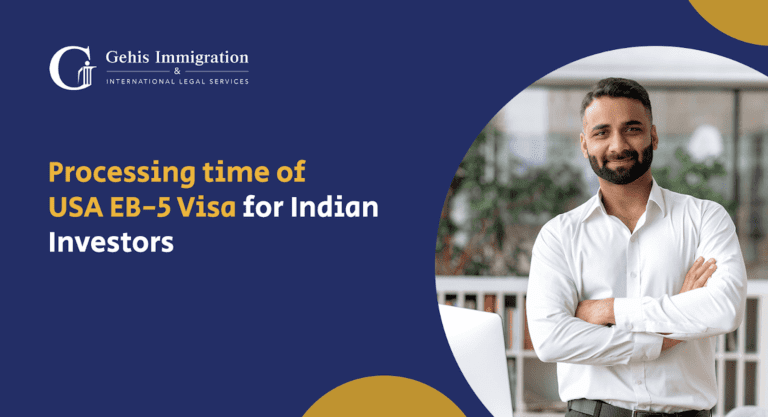Introduction
The EB-5 investor Visa for Indians program, administered by the United States Citizenship and Immigration Services (USCIS), has long been an attractive avenue for Indian investors seeking permanent residency in the United States. Indian investors can invest in job-creating ventures in the United States through the EB-5 Immigrant Investor Program, which offers a pathway to permanent residency and U.S. citizenship for themselves and their families.
The significance of the EB-5 Visa for Indian investors cannot be overstated, given its potential benefits in immigration, education, business opportunities, and quality of life. Given in this blog is the specific aspect of the EB-5 investor Visa program for Indians —its processing time—and provides valuable insights, analysis, and guidance for Indian investors through this complex immigration process. In doing so, we will explore the factors affecting processing times, strategies to expedite the process, recent policy changes, legal challenges, and more, with the ultimate goal of helping Indian investors make informed decisions about their EB-5 Visa journey.
What is the Background Of the EB-5 Investor Visa program for Indians?
The EB-5 investor Visa program for Indians, officially known as the Employment-Based Fifth Preference Visa Program or US Golden Visa, was established by the United States Congress in 1990. Its primary purpose was to stimulate the U.S. economy by attracting foreign investment and creating jobs for U.S. workers.
Under this program, eligible foreign investors and their immediate family members can apply for lawful permanent residency in the United States, commonly known as a “green card.” To qualify for the program, investors must invest substantially in a new commercial enterprise that creates or preserves a certain number of full-time jobs for qualifying U.S. workers.
To participate in the EB-5 Investor Visa program, Indians
investors are generally required to meet specific investment thresholds. Such as:
Investing $1.8 million in a new commercial enterprise anywhere in the United States.
Invest $900,000 in a Targeted Employment Area (TEA), which can be a rural area with high unemployment or an area with high unemployment in an urban setting.
Creating or preserving at least 10 full-time jobs for qualifying U.S. workers within two years of the investor’s admission to the United States as a conditional permanent resident.
It’s essential to note that the minimum investment thresholds and other EB-5 investor visa programs for Indians requirements may change over time due to legislative amendments or regulatory updates.
The EB-5 investor Visa program for Indians is subject to an annual visa quota, affecting processing times and availability for applicants from different countries. The program allocated approximately 10,000 EB-5 visas annually. Within this allocation, country-specific limitations were in place to ensure diversity among visa recipients. A maximum of 7% of the total EB-5 visas could be issued to nationals of any country in a fiscal year.
Country-specific limitations can cause significant variations in processing times for investors from high-demand countries, such as India and China, due to visa backlogs
The EB-5 Visa program’s specific investment requirements, annual visa quotas, and country-specific limitations may have evolved over time. It is crucial to consult a legal counsel for the most up-to-date information regarding the program.
What is the EB-5 Investor Visa Program for Indians Application Process?
The EB-5 Investor Visa program application for Indians process is a multi-step journey that requires meticulous planning and documentation.
Making the required investment in a new commercial enterprise.
Submitting the required documents, Immigrant Petition by Alien Investor.
Upon approval of the required documents, the investor can either adjust their status if they are already in the United States or apply for an immigrant visa through consular processing if they are abroad.
Upon entry to the United States, the investor receives conditional permanent residency
The investor must file documents within 21 to 24 months to remove the conditions on their permanent residency
The investor’s country-of-charge ability can significantly impact processing times due to country-specific limitations and visa backlogs. Visa backlogs can result from high demand from certain countries, such as China and India.
The Visa Bulletin:
Visa published monthly by the U.S. Department of State dictates visa availability and can lead to waiting periods for applicants. The processing efficiency of the United States Citizenship and Immigration Services (USCIS) can affect application timelines. Thorough verification of investment funds can lead to processing delays if additional documentation or clarifications are required.
The processing times for Indian investors under the EB-5 Visa program have experienced variations over the years. These times can range from several months to years, depending on visa backlog and USCIS workload.
Historically, Indian investors have faced increasing processing times due to the growing demand for EB-5 investor visas for Indians. Visa backlogs have been a significant challenge, resulting in longer waiting periods for Indian applicants.
Recent policy changes and developments, including investment thresholds and visa allocation updates, have influenced processing times. Additionally, changes in USCIS adjudication policies and procedures have impacted the overall EB-5 Visa processing landscape.
What are some of the Strategies to Expedite EB-5 Visa Processing?
Premium processing can expedite an EB-5 Visa application by providing faster processing times for certain visa types.
Centre Of Application: Choosing between a Regional Center investment and a Direct Investment can impact processing times. Regional Center projects can be pre-approved by USCIS, leading to a more predictable and streamlined adjudication process. Direct investments, on the other hand, require more extensive documentation and scrutiny. However, Successful direct investment cases can lead to faster permanent residency than regional center-based cases in high-demand countries.
Early Preparation and Documentation: Early preparation and thorough documentation are essential to expedite processing. Investors should ensure have all necessary financial records, investment documents, and source of funds documentation well-organized and ready for submission. Early preparation can help prevent RFEs (Requests for Evidence) and delays caused by incomplete or insufficient documentation.
Legal Counsel and EB-5 Consultants:
Engaging legal counsel and experienced EB-5 consultants is crucial for expediting processing and ensuring compliance with complex immigration regulations. Knowledgeable professionals can guide investors through the process, help select suitable investment projects, & ensure that all documentation meets USCIS requirements. Legal counsel can also help in any legal challenges that may arise during the application process, helping to minimize delays.





